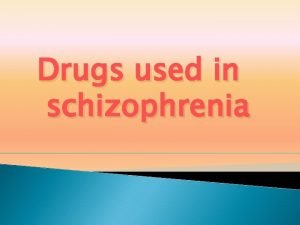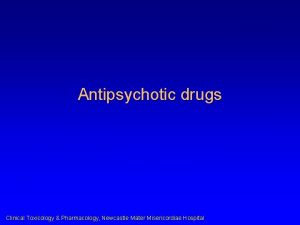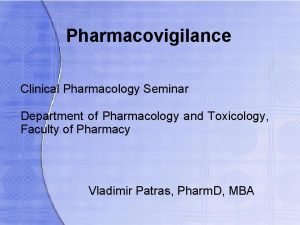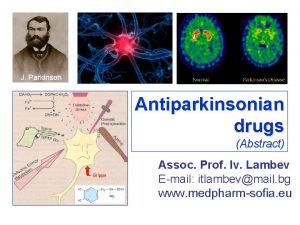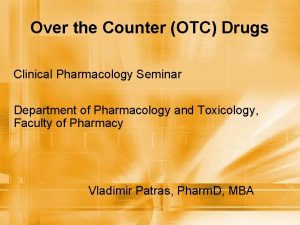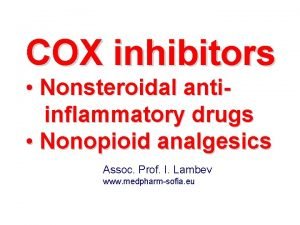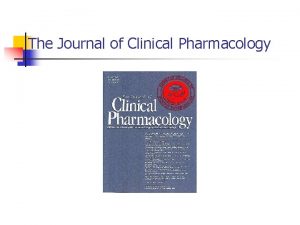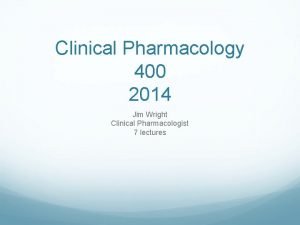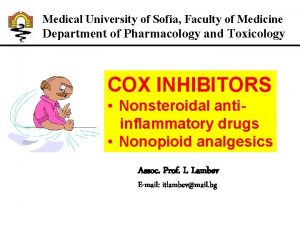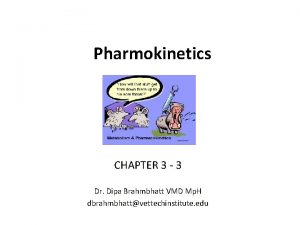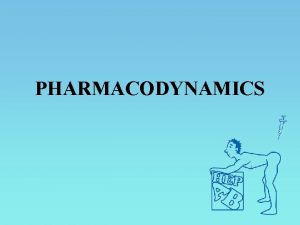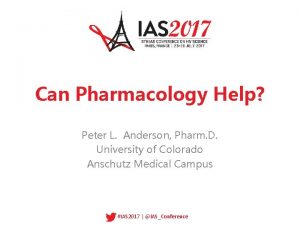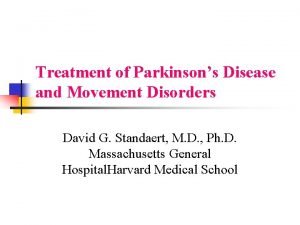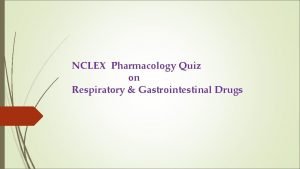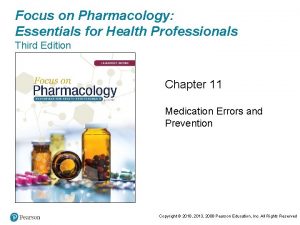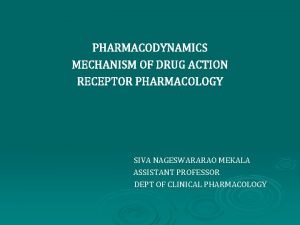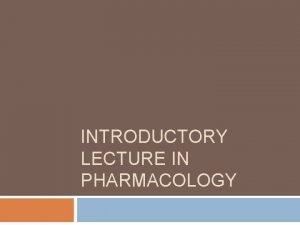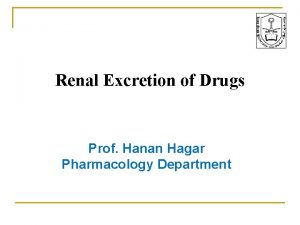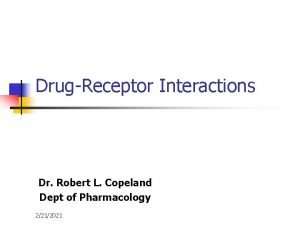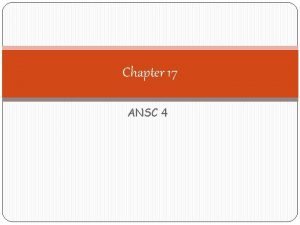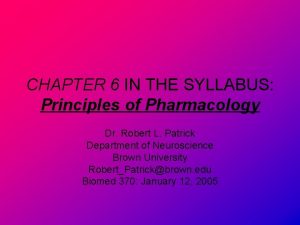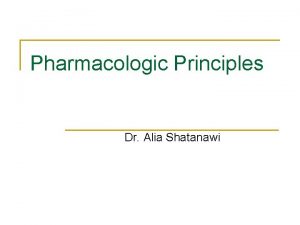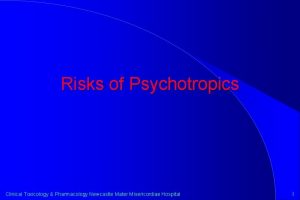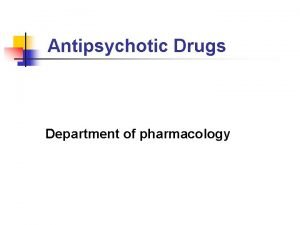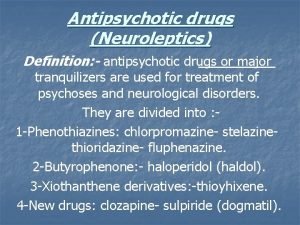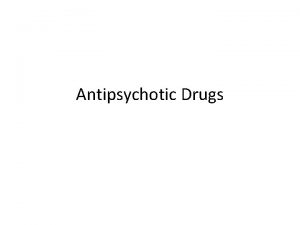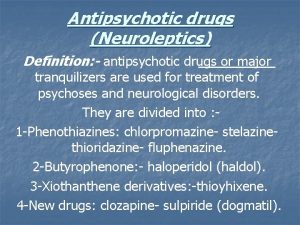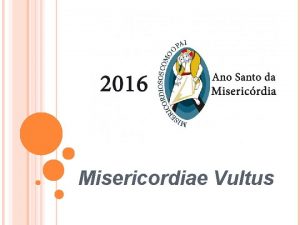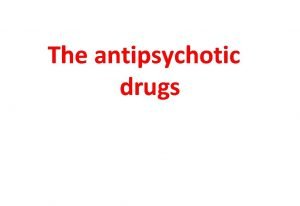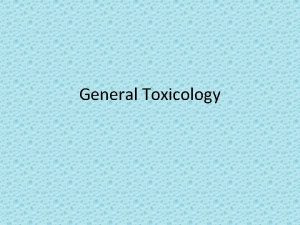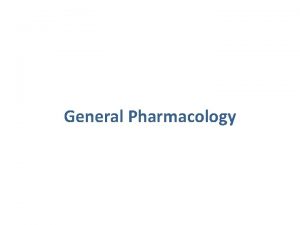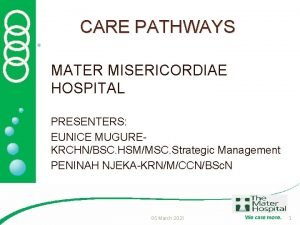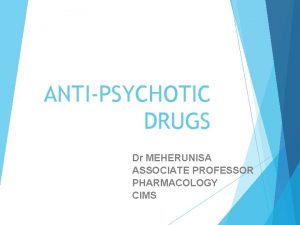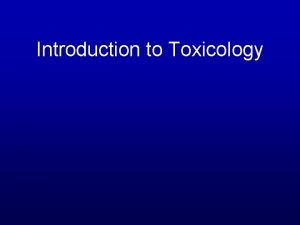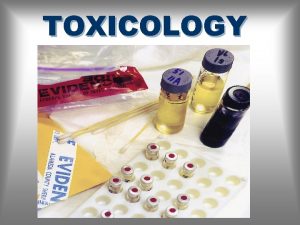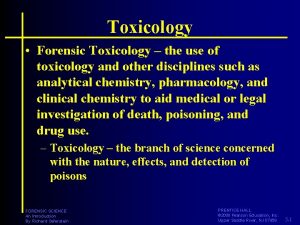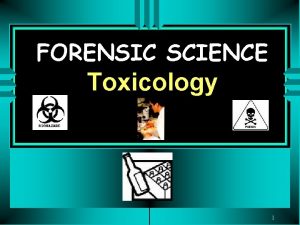Antipsychotic drugs Clinical Toxicology Pharmacology Newcastle Mater Misericordiae






























- Slides: 30

Antipsychotic drugs Clinical Toxicology & Pharmacology, Newcastle Mater Misericordiae Hospital

CNS drugs N N N Functionally, the CNS is the most complex part of the body, and understanding drug effects is difficult Understanding the effects of drugs on individual neurons does not predict the effect on the whole organ In part this is due to complex interactions mediated by different neurotransmitters Clinical Toxicology & Pharmacology, Newcastle Mater Misericordiae Hospital

Dopamine N N N Important neurotransmitter Present mainly in the nigrostriatal, mesolimbic and tubero-infundibular pathways Originally there were only thought to be two main groups of dopamine receptor: D 1 and D 2. These stimulate and inhibit adenylate cyclase respectively Subsequently D 3 (related to D 1) and D 4 (related to D 2 ) receptors were discovered D 2 receptors are mainly responsible for the actions of anti-psychotic drugs Clinical Toxicology & Pharmacology, Newcastle Mater Misericordiae Hospital

Clinical Toxicology & Pharmacology, Newcastle Mater Misericordiae Hospital

Dopamine functions N Motor control - nigrostriatal system – Deficiency results in rigidity, tremor and difficulty initiating movement N Behavioural effects - mesolimbic system – Overactivity in rats leads to abnormal behavior N Endocrine control - tubero-infundibular system – Dopamine and dopamine agonists suppress prolactin release, dopamine antagonists may stimulate it Clinical Toxicology & Pharmacology, Newcastle Mater Misericordiae Hospital

Schizophrenia - dopamine N N N Amphetamine (which releases dopamine) can produce a syndrome similar to the ‘positive’ features of schizophrenia Levodopa may aggravate the condition Apomorphine and bromocriptine (D 2 agonists) produce behavioral abnormalities in animals D 2 receptor antagonists are effective in controlling the positive features of the disorder ? Increased D 2 receptor binding in the brains of schizophrenic subjects. Evidence of genetic variation in the D 4 receptor to which some antipsychotic drugs have high affinity Clinical Toxicology & Pharmacology, Newcastle Mater Misericordiae Hospital

Schizophrenia - serotonin N N N LSD which has mixed agonist/antagonist serotonergic actions produces hallucinations and behavioral disturbance Some antipsychotic drugs also act at 5 HT receptors (antagonists of 5 HT 2) 5 -HT has a modulatory effect on dopaminergic neurones Clinical Toxicology & Pharmacology, Newcastle Mater Misericordiae Hospital

Modes of action N N N All anti-psychotic drugs have inhibitory effects on the D 2 receptor Some have actions against the D 4 receptor All have other effects - to varying degrees – Serotonin 5 HT 2 blockade (may improve negative symptoms) – Histamine H 1 blockade (drowsiness) – Alpha adrenoceptor blockade (postural hypotension) Clinical Toxicology & Pharmacology, Newcastle Mater Misericordiae Hospital

How do we know they work? N Mostly “ by accident” for early drugs – designing drugs to reduce anxiety in surgical patients N N Clinical experience Clinical trials – especially more recent drugs N PET scanning showing blockade of central D 2 receptors Clinical Toxicology & Pharmacology, Newcastle Mater Misericordiae Hospital

Clinical effects N Control the ‘positive’ features of the disease, but little effect on the ‘negative’ features – clozapine may be superior in this regard N The main side-effects are on the extrapyramidal motor system – Akathisia (hours) – Dystonias (hours to days) – Parkinsonism (weeks to months) l rigidity, tremor, and loss of mobility – Tardive dyskinesia (months to years) l l Repetitive abnormal movements of face and upper limbs Thought to be due to proliferation of D 2 receptors in the striatum Clinical Toxicology & Pharmacology, Newcastle Mater Misericordiae Hospital

Clinical effects N Newer ‘atypical’ anti-psychotic drugs are less inclined to produce these effects - possible due to their greater affinity for the mesolimbic over the striatal areas of the brain Clinical Toxicology & Pharmacology, Newcastle Mater Misericordiae Hospital

Other effects N N N N Some are effective anti-emetics Anti-muscarinic effects lead to dry mouth, blurred vision, difficulty with micturition a antagonist effects lead to postural hypotension Antihistamine effects (H 1 receptor) lead to drowsiness Prolactin stimulation may lead to breast development Agranulocytosis is fairly common with an ‘atypical’ drug – clozapine which can also cause a myocarditis ‘Neuroleptic malignant syndrome’ is a rare but serious effect leading to extrapyramidal rigidity, autonomic instability and hyperthermia Clinical Toxicology & Pharmacology, Newcastle Mater Misericordiae Hospital

Other effects Clinical Toxicology & Pharmacology, Newcastle Mater Misericordiae Hospital

Clinical Toxicology & Pharmacology, Newcastle Mater Misericordiae Hospital

Traditional Antipsychotics N Phenothiazines – chlorpromazine (Chlorpromazine Mixture, Chlorpromazine Mixture Forte, Largactil) – fluphenazine (Anatensol, Modecate) – flupenthixol (Fluanxol) – pericyazine (Neulactil) – pimozide (Orap) – thioridazine (Aldazine) – trifluoperazine (Stelazine) – zuclopenthixol (Clopixol) N Butyrophenones – droperidol (Droleptan Injection) – haloperidol (Haldol, Serenace) Clinical Toxicology & Pharmacology, Newcastle Mater Misericordiae Hospital

Clinical Toxicology & Pharmacology, Newcastle Mater Misericordiae Hospital

Newer Antipsychotics N Atypical agents – aripiprazole (Abilify) – clozapine (Clo. Syn, Clopine, Clozaril) – risperidone (Risperdal) – quetiapine (Seroquel) – amisulpride (Solian) – olanzapine (Zyprexa) Clinical Toxicology & Pharmacology, Newcastle Mater Misericordiae Hospital

Antipsychotics Clinical Toxicology & Pharmacology, Newcastle Mater Misericordiae Hospital

Differences among Antipsychotic Drugs N Chlorpromazine: α 1 = 5 -HT 2 > D 1 N Haloperidol: D 2 > D 1 = D 4 > α 1 > 5 -HT 2 N Clozapine: D 4 = α 1 > 5 -HT 2 > D 2 = D 1 Clinical Toxicology & Pharmacology, Newcastle Mater Misericordiae Hospital

Atypical antipsychotics N Claims – – N lower doses reduced side effects more effective (especially negative symptoms) better compliance Evidence? – trials have been quite small and involved patients previously heavily treated and somewhat ‘resistant’ – trials have tended to show equivalent efficacy and better side effect profiles with newer drugs – head to head trials claimed superiority of olanzapine over risperidone (but company sponsored and controversial); some “parallel publications” N Costs – Much higher with new drugs (10 -40 times higher) Clinical Toxicology & Pharmacology, Newcastle Mater Misericordiae Hospital

Metabolic effects Weight gain over 1 year (kg) aripiprazole 1 amisulpride 1. 5 quetiapine 2– 3 risperidone 2– 3 olanzapine >6 clozapine >6 Clinical Toxicology & Pharmacology, Newcastle Mater Misericordiae Hospital

Insulin resistance N N N Prediabetes (impaired fasting glycaemia) has ~ 10% chance / year of converting to Type 2 diabetes Prediabetes plus olanzapine has a 6 fold increased risk of conversion If olanzapine is stopped 70% will revert back to prediabetes Clinical Toxicology & Pharmacology, Newcastle Mater Misericordiae Hospital

Stroke in the elderly N N Risperidone and olanzapine associated with increased risk of stroke when used for behavioural control in dementia Risperidone 3. 3% vs 1. 2% for placebo Olanzapine 1. 3% vs 0. 4% for placebo However, large observational database studies – Show no increased risk of stroke compared with typical antipsychotics or untreated dementia patients Clinical Toxicology & Pharmacology, Newcastle Mater Misericordiae Hospital

Conclusions N N N Atypical antipsychotics have serotonin blocking effects as well as dopamine blockade As a group have less chance of extrapyramidal side effects Most have weight gain and insulin resistance as a side effect (except perhaps aripiprazole and maybe amisulpride) May be associated with stroke when used for behavioural control in dementia Many have idiosyncratic toxicities Clinical Toxicology & Pharmacology, Newcastle Mater Misericordiae Hospital

Clinical Toxicology & Pharmacology, Newcastle Mater Misericordiae Hospital

Clinical Toxicology & Pharmacology, Newcastle Mater Misericordiae Hospital

Clinical Toxicology & Pharmacology, Newcastle Mater Misericordiae Hospital

Differences among Antipsychotic Drugs N N All effective antipsychotic drugs block D 2 receptors Chlorpromazine and thioridazine – block α 1 adrenoceptors more potently than D 2 receptors – block serotonin 5 -HT 2 receptors relatively strongly – affinity for D 1 receptors is relatively weak N Haloperidol – acts mainly on D 2 receptors – some effect on 5 -HT 2 and α 1 receptors – negligible effects on D 1 receptors N Pimozide and amisulpride† – act almost exclusively on D 2 receptors Clinical Toxicology & Pharmacology, Newcastle Mater Misericordiae Hospital

Differences among Antipsychotic Drugs N Clozapine – binds more to D 4, 5 -HT 2, α 1, and histamine H 1 receptors than to either D 2 or D 1 receptors N Risperidone – about equally potent in blocking D 2 and 5 -HT 2 receptors N Olanzapine – more potent as an antagonist of 5 -HT 2 receptors – lesser potency at D 1, D 2, and α 1 receptors N Quetiapine – lower-potency compound with relatively similar antagonism of 5 -HT 2, D 2, α 1, and α 2 receptors Clinical Toxicology & Pharmacology, Newcastle Mater Misericordiae Hospital

Differences among Antipsychotic Drugs N Clozapine, olanzapine and quetiapine – potent inhibitors of H 1 histamine receptors – consistent with their sedative properties N Aripiprazole – partial agonist effects at D 2 and 5 -HT 1 A receptors Clinical Toxicology & Pharmacology, Newcastle Mater Misericordiae Hospital
 Salve mater misericordiae
Salve mater misericordiae Antipsychotic drugs classification
Antipsychotic drugs classification Annual review of pharmacology and toxicology
Annual review of pharmacology and toxicology Toxicology and applied pharmacology
Toxicology and applied pharmacology Tactcardia
Tactcardia Adrenal drugs pharmacology
Adrenal drugs pharmacology Pharmacology of drugs acting on respiratory system
Pharmacology of drugs acting on respiratory system Clinical pharmacology seminar
Clinical pharmacology seminar Basic & clinical pharmacology
Basic & clinical pharmacology Spremicides
Spremicides Clinical pharmacology powered by clinicalkey
Clinical pharmacology powered by clinicalkey Analglesia
Analglesia Clinical pharmacology
Clinical pharmacology Clinical pharmacology residency
Clinical pharmacology residency Basic & clinical pharmacology
Basic & clinical pharmacology Bula misericordiae vultus
Bula misericordiae vultus Misericordiae vultus meaning
Misericordiae vultus meaning First pass effect drugs
First pass effect drugs Tachyphylaxis
Tachyphylaxis Pharmacology tutor anderson
Pharmacology tutor anderson Dopamine blockers
Dopamine blockers Respiratory pharmacology quiz
Respiratory pharmacology quiz Focus on pharmacology essentials for health professionals
Focus on pharmacology essentials for health professionals Receptors in pharmacology
Receptors in pharmacology What is pharmacology
What is pharmacology What is ion trapping in pharmacology
What is ion trapping in pharmacology Pharmacology definition
Pharmacology definition Filtration pharmacology
Filtration pharmacology Pharmacology definition
Pharmacology definition What is pharmacology
What is pharmacology What is pharmacology
What is pharmacology

